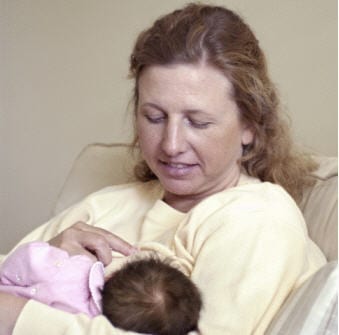For many pregnant women who plan to breastfeed, one of the biggest concerns is, “will it hurt?” The answer is that the early weeks of breastfeeding are different for everyone. Some women might have just a little soreness, and still others will be lucky enough to not experience any discomfort! You can’t predict how your body will adjust to breastfeeding. You’ll have to wait for that first latch to find out. You can, however, gather as much information as possible so you can know what to do if you do experience some challenges in the first few days. Knowing that what you are experiencing is normal can be comforting and less isolating. Some tenderness is normal when you first begin breastfeeding. But if that turns to pain that won’t go away, adjustments should be made. Nipple soreness and pain are often cited as the main reason women discontinue breastfeeding, and many moms think that soreness just comes with the territory. But that’s not the case! Breastfeeding done right can be comfortable, and if you can believe it, even a calming, soothing experience. There are a few different things you can try to ease the discomfort.
Nipple pain
Incorrect positioning of the baby, which leads to a poor latch, is the most common cause of nipple pain when women are nursing. Make sure the baby’s head and mouth are even with the nipple, and that the baby is facing the breast. Also, your baby will need to take the nipple and a good part of the areola tissue into his or her mouth to properly latched on. This will help mitigate the problem of sore, cracked nipples.
If your nipples do become sore or cracked, applying lanolin will soothe and protect your nipple. Look for a brand that contains “medical grade lanolin” and contains no preservatives, so it doesn’t have to be wiped off before feeding the baby. There are also soothing gel pads which work in the same way as lanolin in that they soothe and protect delicate and sore nipples. Look for gel pad that has a cloth backing as that helps ease bra friction.
Engorgement
Swollen breasts, or engorgement, is another common complaint of breastfeeding moms. This is caused by a large supply of milk combined with extra blood and fluids supplied to your breasts in preparation for feeding. This temporary condition begins about the third day postpartum and is marked by breasts feeling heavy and warm. The skin will feel tight and may look shiny with a hardened areola. The best way to alleviate this discomfort is to nurse frequently. This might be difficult, as it’s hard for baby to latch onto an engorged breast. If it’s too difficult to nurse or latch on the baby, hot showers will help soften the breast tissue making it easier for baby to feed. You can also try to express some of the milk either by hand expression or with a manual or electric pump. Express just enough to soften the breast so the baby can properly latch on. After nursing, using ice packs can help keep the swelling down and relieve the pain. Flattened nipples can be another side effect of engorgement or swelling. Techniques such as “Reverse Pressure Softening” (La Leche League’s Web site has a great how-to guide) are very helpful in drawing out a flattened nipple and there are specialized products that are specifically designed to gently draw out your nipples so your baby can latch on easier and breastfeed, relieving the pressure.
Leaking
Another common problem you might experience in the early months of nursing is leaking. While it’s not painful, it can be embarrassing and the constant moisture against the skin might cause irritation. Nursing pads can be used to capture wetness and prevent sore nipples and irritation of the skin by keeping the moisture inside the pad and away from the breast.
Remember…
The most important thing to remember is that you don’t need to fight through the pain! The stress of that alone could keep you from nursing as long as you planned to. Try the solutions I mention here, or call your lactation consultant and ask for help. To find a local lactation consultant in your area, see the International Lactation Consultant Association website: www.ILCA.org.
About the Author
Gina Ciagne is the Director of Breastfeeding Relations and Outreach for Lansinoh Laboratories. She is a Certified Lactation Counselor (CLC) and a La Leche League International- trained breastfeeding peer counselor and has worked with many breastfeeding mothers. She is currently preparing to take the boards to become an International Board Certified Lactation Consultant (IBCLC). She is the mother of two breastfed children–a daughter and a son, each of whom she breastfed for over a year.





